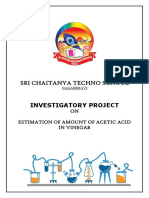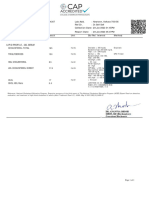12th chemistry IP (1)
Uploaded by
jayendrens12th chemistry IP (1)
Uploaded by
jayendrensINVESTIGATORY PROJECT
CHEMISTRY
ALL INDIA SENIOR SECONDARY
EXAMINATION (CBSE)
TOPIC: Measuring the Amount of Acetic Acid in Vinegar by Titration
with an Indicator solution.
CLASS: XII-B
SUBMITTED BY: Stanley Jeremy Alfred
STANLEY JEREMY ALFRED
Mrs. MERLIN
CHEMISTRY
ACKNOWLEDGEMENT
I would like to express my special thanks of gratitude to my teacher Mrs. Merlin for her
guidance, support throughout the duration of the project. I completed the project successfully by
her motivation and her extended support.
I would like to thank our Correspondent Dr. R. Kishore kumar, our Principal Mrs. Shanthi
Samuel and our Vice principle Mr. Jaya kumar who gave me the opportunity to work on this
project, which in turn drove me in doing a lot of Research and analysis in the chosen topic.
Finally, I would also like to thank my parents and friends who supported me in completing
this project within the limited time frame.
TABLE OF CONTENT
S.NO CONTENT PG.NO
1. OBJECTIVE 1
2. INTRODUCTION 2
3. APPARATUS REQUIRED 4
4. THEORY 5
5. EXPERIMENTAL PROCEDURE 6
6. OBSERVATIONS 7
7. RESULT 10
8. PRECAUTIONS 11
9. ADVANTAGES OF ACETIC ACID 12
10. HEALTH BENEFITS OF ACETIC ACID 14
11. DISADVANTAGES OF ACETIC ACID 16
12. BIOLOGICAL USES OF ACETIC ACID 18
13. BIBLIOGRAPHY 20
St. John’s Public School
CHENNAI-600100
OBJECTIVE
The goal of this project is to determine the amount of Acetic Acid in different types of vinegar using
titration with a coloured pH indicator to determine the endpoint.
Undergoing the
process of titration
1
St. John’s Public School
CHENNAI-600100
INTRODUCTION
About Vinegar:
Vinegar is a solution made from the fermentation of ethanol (CH3CH2OH ) , which in turn
was previously fermented from sugar. The fermentation of ethanol results in the production
of acetic acid (CH3COOH). There are many different types of vinegar, each starting from a
different original sugar source ( e.g., rice, wine, malt, etc.) .
The amount of acetic acid in vinegar can vary, typically between 4 to 6% for table vinegar,
but up to three times higher ( 18%) for pickling vinegar . Titration introduction: In this
project, I have determined the amount of acid in different vinegars using titration, a common
technique in chemistry. Titration is a way to measure the unknown amount of a chemical in
a solution (the titrant) by adding a measured amount of a chemical with a known
concentration (the titrating solution).
The titrating solution reacts with the titrant, and the endpoint of the reaction is monitored in
some way. The concentration of the titrant can now be calculated from the amount of
titrating solution added, and the ratio of the two chemicals in the chemical equation for the
reaction.
Titration introduction:
In this project, I have determined the amount of acid in different vinegars using titration, a
common technique in chemistry. Titration is a way to measure the unknown amount of a
chemical in a solution (the titrant) by adding a measured amount of a chemical with a known
concentration (the titrating solution).
The titrating solution reacts with the titrant, and the endpoint of the reaction is monitored in
some way. The concentration of the titrant can now be calculated from the amount of titrating
solution added, and the ratio of the two chemicals in the chemical equation for the reaction.
Titration theory:
To measure the acidity of a vinegar solution, we can add enough hydroxyl ions to balance out the
added hydrogen ions from the acid. The hydroxyl ions will react with the hydrogen ions to
produce water. In order for a titration to work, we need three
things:
1. a titration solution (contains hydroxyl ions with a precisely
known concentration),
2. a method for delivering a precisely measured volume of the
titrating solution, and
3. a means of indicating when the endpoint has been reached.
For the titrating solution, we'll use a dilute solution of sodium hydroxide (NaOH). Sodium
hydroxide is a strong base, which means that it dissociates almost completely in water . So for
every NaOH molecule that we add to the solution,we can expect to produce a hydroxyl ion.
2
St. John’s Public School
CHENNAI-600100
Performing titration:
To dispense an accurately measured volume of the titrating solution, we will use a
burette. A burette is a long tube with a valve at the bottom and graduated markings
on the outside to
measure the volume contained in the burette. The burette is mounted on a ring stand,
directly above the titrant solution .
Solutions in the burette tend to creep up the sides of the glass at the surface of the
liquid. This is due to the surface tension of water. The surface of the liquid thus
forms a curve, called a
meniscus. To measure the volume of the liquid in the burette, always read from the
bottom of the meniscus.
Indicators:
In this experiment, we will use an indicator solution called phenolphthalein. Phenolphthalein
is colourless when the solution is acidic or neutral. When the solution becomes slightly basic,
phenolphthalein turns pinkish, and then light purple as the solution becomes more basic. So
when the vinegar solution starts to turn pink, we know that the titration is complete.
3
St. John’s Public School
CHENNAI-600100
APPARATUS
To do this experiment we will need the following materials and equipment:
➔Vinegar (three different types)
➔Distilled water
➔Small funnel
➔0.5% Phenolphthalein solution in alcohol (pH indicator solution)
➔0.1 M sodium hydroxide solution
➔125 mL Conical flask
➔25 or 50 mL burette
➔10 mL graduated cylinder
➔Ring stand
➔Burette clamp
4
St. John’s Public School
CHENNAI-600100
THEORY
Required amount of sodium hydroxide (NaOH) can be calculated using the following formula:
W= Molarity X Molar Mass X Volume (cm3)
1000
Molar mass of NaOH = 40 g/mol
= 0.5 X 40 X 500
1000
= 10 g
The acetic acid content of a vinegar may be determined by titrating a vinegar sample with a solution of
sodium hydroxide of known molar concentration (molarity).
CH3COOH(aq) + NaOH(aq) --> CH3COONa(aq) + H2O(l)
(acid) + (base) --> (salt) + (water)
At the end point in the titration stoichiometry between the both solution lies in a 1:1 ratio.
M (CH3COOH) X V (CH3COOH) =M (NaOH) X V (NaOH)
Strength of acid in vinegar can be determined by the following
formula:
Strength of acetic acid = M (CH3COOH) X 60
Indicator: Phenolphthalein
End Point: Colorless to pink
5
St. John’s Public School
CHENNAI-600100
EXPERIMENTAL PROCEDURE
1. Pour 1.5 ml of vinegar in an Conical flask.
2. Add distilled water to dissolve the vinegar so that the volume of the solution becomes 20 ml.
3. Add 3 drops of 0.5% phenolphthalein solution.
4. Use the burette clamp to attach the burette to the ring stand. The opening at the bottom of the
burette should be just above the height of the Conical flask we use for the vinegar and
phenolphthalein solution.
5. Use a funnel to fill the burette with a 0.1 M solution of sodium hydroxide.
6. Note the starting level of the sodium hydroxide solution in the burette. Put the vinegar solution
to be titrated under the burette.
7. Slowly drip the solution of sodium hydroxide into the vinegar solution. Swirl the flask gently to
mix the solution, while keeping the opening underneath the burette.
8. At some point we will see a pink colour in the vinegar solution when the sodium hydroxide is
added, but the colour will quickly disappear as the solution is mixed. When this happens, slow the
burette to drop-by-drop addition.
9. When the vinegar solution turns pink and remains that colour even with mixing, the titration is
complete. Close the tap (or pinch valve) of the burette.
10. Note the remaining level of the sodium hydroxide solution in the burette. Remember to read
from the bottom of the meniscus.
11. Subtract the initial level from the remaining level to figure out how much titrating solution we
have used.
12. For each vinegar that we test, repeat the titration at least three times.
6
St. John’s Public School
CHENNAI-600100
OBSERVATION 1
Take the laboratory vinegar in the conical flask and do the
titration with NaOH as mentioned.
Sr. No. Volume of Vinegar in Burette reading Volume of
solution (in ml) NaOH
Initial (in ml) Final (in ml) solution used
(in ml)
1. 20 0 15.2 15.2
2. 20 0 15.2 15.2
3. 20 0 15.2 15.2
Concordant value = 15.2 ml
We know that:-
M(CH3COOH) X V(CH3COOH) = M(NaOH) X V(NaOH)
M(CH 3COOH) = M(NaOH) X V(NaOH)
V(CH 3COOH)
M(CH 3COOH) = 0.5 X 15.2 = 0.38 mol/L
20
Strength of acetic acid = 0.38 X 60 g/L = 22.8 g/L
St. John’s Public School
CHENNAI-600100
OBSERVATION 2
Take the household vinegar in the conical flask and do the
titration with NaOH as mentioned.
Sr. No. Volume of Vinegar in Burette reading Volume of
solution (in ml) NaOH
Initial (in ml) Final (in ml) solution used
(in ml)
1. 10 0 13.5 13.5
2. 10 0 13.5 13.5
3. 10 0 13.5 13.5
Concordant value = 13.5 ml
We know that:-
M(CH3COOH) X V(CH3COOH) = M(NaOH) X V(NaOH)
M(CH 3COOH) = M(NaOH) X V(NaOH)
V(CH 3COOH)
M(CH 3COOH) = 0.5 X 13.5 = 0.675 mol/L
10
Strength of acetic acid = 0.675 X 60 g/L = 40.5 g/L
St. John’s Public School
CHENNAI-600100
OBSERVATION 3
Take the wine vinegar in the conical flask and do the
titration with NaOH as mentioned.
Sr. No. Volume of Vinegar in Burette reading Volume of
solution (in ml) NaOH
Initial (in ml) Final (in ml) solution used
(in ml)
1. 10 0 24 24
2. 10 0 24 24
3. 10 0 24 24
Concordant value = 24 ml
We know that:-
M(CH3COOH) X V(CH3COOH) = M(NaOH) X V(NaOH)
M(CH 3COOH) = M(NaOH) X V(NaOH)
V(CH 3COOH)
M(CH 3COOH) = 0.5 X 24 = 1.2 mol/L
10
Strength of acetic acid = 1.2 X 60 g/L = 72g/L
St. John’s Public School
CHENNAI-600100
RESULT
➢ Strength of acetic acid in laboratory vinegar = 22.8 g/L
➢ Strength of acetic acid in household vinegar = 40.5 g/L
➢ Strength of acetic acid in wine vinegar = 72 g/L
Graphically plotting various vinegar samples in accordance with the amount of acetic acid present in them we
present a stunning find :-
Order of amount of acetic acid in vinegar is:-
Wine Vinegar > Household Vinegar > Laboratory Vinegar
10
St. John’s Public School
CHENNAI-600100
PRECAUTIONS
➢ Transfering of measured vinegar into a measuring flask should be done very carefully .
➢ Measuring must be performed carefully.
➢ Look at the meniscus of solution at eye level to avoid parallax.
➢ Look at the lower meniscus in the light coloured solution and upper meniscus in the dark
coloured solution because of visibility.
➢ Do not forget to add distilled water to the vinegar.
11
St. John’s Public School
CHENNAI-600100
ADVANTAGES OF ACETIC ACID
Acetic acid is widely used across various industries due to its versatility and chemical properties.
Here are some of its major uses:
1. Food Industry (Vinegar)
• Role: Acetic acid is a key ingredient in vinegar (4-8% acetic acid), commonly used in cooking,
preserving, and flavoring.
• Purpose: It acts as a natural preservative due to its antimicrobial properties, making it effective in
pickling vegetables and preserving sauces, condiments, and dressings.
2. Chemical Industry
• Role: Acetic acid serves as a primary raw material in the production of various chemicals,
including:
o Acetate esters (e.g., ethyl acetate and butyl acetate) used as solvents in inks, paints, and coatings.
o Acetic anhydride, used in making cellulose acetate for photographic films and textiles.
• Purpose: It is a building block for many chemicals and materials, making it essential for large-scale
manufacturing processes.
3. Pharmaceuticals
• Role: Acetic acid is involved in synthesizing several pharmaceutical products, such as aspirin,
where it acts as a reactant in the production of the active ingredient.
• Purpose: Used for its chemical properties to create active pharmaceutical ingredients, aiding in the
production of medications with anti-inflammatory and pain-relieving effects.
4. Textiles and Dyeing
• Role: Acetic acid is used to control the pH level in textile processing and dyeing, ensuring optimal
dye adherence and vibrant colors.
• Purpose: Helps improve the quality of dyes and maintain the fabric’s integrity during processing,
particularly in the production of synthetic fibers.
5. Plastics Production
• Role: Acetic acid is a critical precursor in manufacturing polyethylene terephthalate (PET), a type
of plastic used in bottles, food containers, and other products.
• Purpose: PET is widely used in packaging and consumer goods, and acetic acid’s role as a
feedstock is central to its production.
6. Household Cleaning
• Role: Diluted acetic acid (vinegar) is used as a household cleaner due to its ability to dissolve
mineral deposits, remove dirt, and act as a mild disinfectant.
• Purpose: Effective for cleaning glass, removing limescale, deodorizing surfaces, and killing some
types of bacteria and molds, making it a safe and eco-friendly cleaning solution.
12
St. John’s Public School
CHENNAI-600100
7. Agriculture
• Role: Acetic acid is used as a herbicide, particularly in organic farming, to control weeds without
using synthetic chemicals.
• Purpose: When applied to plants, the acid helps in breaking down cell walls, which ultimately kills
weeds. This is popular in environments seeking alternatives to traditional herbicides.
8. Medicine and Healthcare
• Role: Acetic acid is used in medical settings for specific treatments, such as ear infections (in
diluted form) and to screen for cervical cancer.
• Purpose: Its antibacterial properties make it effective in treating certain infections. In cervical
screening, it helps highlight abnormal tissue for closer examination.
9. Laboratory Uses
• Role: Acetic acid is frequently used as a reagent and solvent in laboratories for chemical analysis
and experiments.
• Purpose: It helps create the right pH environments in buffers and is useful in titrations and other
chemical processes due to its weak acid properties.
10. Cosmetics
• Role: Acetic acid is used in the formulation of some skincare products and hair treatments.
• Purpose: It aids in maintaining the skin’s pH balance, can help with acne treatments, and is used to
clarify hair by removing buildup from hair products and hard water.
13
St. John’s Public School
CHENNAI-600100
HEALTH BENEFITS OF ACETIC ACID
Acetic acid, the primary active component of vinegar, offers several health benefits when consumed in
small amounts. Here are some of the key health benefits associated with acetic acid:
1. Blood Sugar Regulation
• Benefit: Acetic acid can improve insulin sensitivity and help regulate blood glucose levels, particularly
after meals.
• Mechanism: It slows the breakdown of carbohydrates, allowing for a more gradual release of glucose
into the bloodstream. Studies show that consuming vinegar with meals can lower post-meal blood
sugar spikes.
2. Weight Management
• Benefit: Regular consumption of acetic acid in vinegar has been associated with reduced body fat
accumulation and weight loss.
• Mechanism: Acetic acid is thought to increase the expression of certain genes involved in fat burning.
It also promotes satiety, which can lead to a lower caloric intake over time.
3. Cholesterol and Heart Health
• Benefit: Some studies suggest that acetic acid may help lower cholesterol and triglyceride levels,
potentially supporting heart health.
• Mechanism: Animal studies indicate that acetic acid can reduce the formation of LDL cholesterol (the
“bad” cholesterol) and improve HDL cholesterol (the “good” cholesterol) levels. However, more
human studies are needed to confirm these effects.
4. Antimicrobial Properties
• Benefit: Acetic acid has been shown to have natural antibacterial and antifungal effects, which can
help reduce harmful bacteria.
• Mechanism: It works by disrupting the cell walls of certain bacteria, including pathogens like E. coli
and Salmonella. This makes vinegar a useful natural preservative for foods and a potential aid in
reducing foodborne illnesses.
5. Improved Digestion
• Benefit: Acetic acid can aid digestion, particularly by promoting the production of digestive enzymes
and stomach acid.
• Mechanism: It may help stimulate the production of pepsin, an enzyme involved in protein
breakdown, and promote stomach acid production, aiding in the overall digestive process.
6. Antioxidant Properties
• Benefit: Acetic acid contributes to the antioxidant properties of vinegar, helping to reduce oxidative
stress.
14
St. John’s Public School
CHENNAI-600100
• Mechanism: Vinegar, especially those made from fruits, contains antioxidant compounds that work
alongside acetic acid to combat free radicals, potentially reducing the risk of chronic diseases.
7. Blood Pressure Regulation
• Benefit: Some studies have linked acetic acid intake with reduced blood pressure levels.
• Mechanism: Acetic acid may help increase calcium absorption and regulate the body’s pH, which
could indirectly influence blood pressure levels. Animal studies have shown reductions in blood
pressure with vinegar intake, though more research in humans is necessary.
8. Skin Health
• Benefit: When diluted and applied topically, acetic acid can improve certain skin conditions.
• Mechanism: Its antimicrobial properties help treat mild skin infections, and it can also help restore the
natural pH of the skin. This is why diluted vinegar is sometimes used as a home remedy for conditions
like acne and eczema.
Note: While acetic acid has many potential health benefits, it’s essential to consume it in moderate
amounts, as high concentrations can irritate the digestive system, tooth enamel, and throat.
15
St. John’s Public School
CHENNAI-600100
DISADVANTAGES OF ACETIC ACID
While acetic acid is valuable in many industries and applications, it does have several disadvantages
and risks, especially at higher concentrations. Here are some of the main drawbacks:
1. Corrosive Nature
• Risk: Acetic acid, especially in concentrated forms (like glacial acetic acid, which is nearly 100%
acetic acid), is highly corrosive. It can cause severe burns on skin contact and can damage metals
and other materials.
• Concern: Requires careful handling and storage in industrial and laboratory settings, increasing the
need for safety measures.
2. Health Risks from Inhalation
• Risk: Inhaling acetic acid vapors can irritate the respiratory tract, causing symptoms like coughing,
sore throat, and difficulty breathing. In extreme cases, exposure to high concentrations can lead to
respiratory distress.
• Concern: Facilities using acetic acid must have good ventilation, and workers need protective
equipment to avoid inhaling vapors, which can complicate its use.
3. Digestive Tract Irritation
• Risk: When ingested in high concentrations, acetic acid can irritate or damage the lining of the
mouth, throat, and digestive tract. Symptoms include pain, nausea, vomiting, and even burns in
severe cases.
• Concern: Even when using vinegar, which is a diluted form of acetic acid, overconsumption can
lead to acid reflux, tooth enamel erosion, and digestive discomfort.
4. Potential for Environmental Harm
• Risk: High concentrations of acetic acid can harm aquatic life if released into water sources,
potentially altering the pH balance and affecting ecosystems.
• Concern: Waste disposal and accidental leaks or spills need to be managed carefully to avoid
environmental damage, especially in industries that use large quantities of acetic acid.
5. Erosive Effect on Tooth Enamel
• Risk: Regular consumption of acetic acid in the form of vinegar can erode tooth enamel over time,
leading to increased sensitivity and higher risk of cavities.
• Concern: Dentists often recommend limiting exposure or rinsing the mouth with water after
consuming vinegar to protect dental health.
6. Flammability (at High Concentrations)
• Risk: Glacial acetic acid is flammable and poses a fire hazard when exposed to open flames or high
temperatures.
16
St. John’s Public School
CHENNAI-600100
• Concern: This makes storage and handling more challenging, as fire prevention protocols must be
in place in facilities where it is used.
7. Unpleasant Odor
• Risk: Acetic acid has a strong, pungent odor, which can be unpleasant and overwhelming,
particularly in confined spaces.
• Concern: In commercial and industrial settings, this can lead to discomfort or aversion, and the
need for odor control measures can increase operational costs.
8. Allergic Reactions and Sensitivity
• Risk: Some individuals may be sensitive to acetic acid, experiencing allergic reactions or skin
irritation when exposed to it, even in lower concentrations.
• Concern: This limits its use in certain personal care products and may require extra labeling or
warnings for sensitive users.
9. Limitations in Medical Use
• Risk: Although acetic acid has antibacterial properties, its corrosive nature limits its use in medical
applications to very low concentrations and specific purposes (e.g., treating ear infections).
• Concern: The potential for tissue damage or irritation restricts its use to specific, diluted
applications under medical supervision.
These disadvantages mean that while acetic acid is versatile and widely useful, safety and
environmental precautions are essential in handling, storage, and usage, particularly in industrial
and concentrated forms.
17
St. John’s Public School
CHENNAI-600100
BIOLOGICAL USES OF ACETIC ACID
Acetic acid plays a significant role in various biological processes and applications. Here are some of
its main biological uses:
1. Metabolism and Cellular Respiration
• Role in Energy Production: Acetic acid is a precursor to acetyl-CoA, a central molecule in the
metabolic pathway. Acetyl-CoA enters the citric acid cycle (Krebs cycle), where it is oxidized to
produce ATP, the main energy currency of cells.
• Lipid Synthesis: Acetyl-CoA, derived from acetic acid, is also essential in the biosynthesis of fatty
acids and cholesterol, which are fundamental components of cell membranes and steroid hormones.
2. Antibacterial and Antifungal Agent
• Antimicrobial Properties: Acetic acid is naturally antimicrobial, especially effective against bacteria
and fungi, which makes it useful in food preservation. This is why vinegar is often used to inhibit
microbial growth in foods like pickles and sauces.
• Applications in Medicine: Acetic acid is sometimes used in diluted form to treat minor infections,
particularly ear infections, as it can eliminate bacteria and some fungi without the need for more
aggressive treatments.
3. Regulation of Blood Glucose Levels
• Influence on Glucose Absorption: Acetic acid, when ingested (as in vinegar), has been shown to help
reduce blood sugar spikes by slowing carbohydrate absorption and enhancing insulin sensitivity.
• Potential for Diabetes Management: Some research suggests that consuming vinegar with meals
could benefit individuals with type 2 diabetes by moderating post-meal blood glucose levels.
4. pH Regulation in Cellular Environments
• Buffering Agent: Acetic acid is often used in biological laboratories as part of buffering solutions to
maintain the pH within certain limits. Buffering solutions with acetic acid help stabilize the pH in
biological experiments, cell cultures, and biochemical assays.
• Role in Human Physiology: While not a primary biological buffer in humans, the body’s metabolism
of acetic acid can help modulate systemic pH, contributing to acid-base homeostasis.
5. Preservation and Fermentation in Food Production
• Microbial Fermentation: Acetic acid bacteria (e.g., Acetobacter and Gluconobacter) convert ethanol
to acetic acid, a key process in the production of vinegar and certain fermented foods. This conversion
also preserves food by creating an acidic environment that inhibits spoilage organisms.
• Role in Fermented Foods: Beyond vinegar, acetic acid contributes to the flavor and preservation of
various fermented foods, including kombucha, kimchi, and sauerkraut, making it valuable in food
microbiology.
18
St. John’s Public School
CHENNAI-600100
6. Antioxidant Properties in the Body
• Reducing Oxidative Stress: Acetic acid has shown antioxidant potential by contributing to the
reduction of reactive oxygen species (ROS) within the body, helping to minimize cellular oxidative
stress.
• Protective Effects: By reducing ROS, acetic acid may play a minor role in protecting cellular
components like DNA, proteins, and lipids from damage, which has implications for aging and disease
prevention.
7. Cell and Molecular Biology Research
• Fixative in Microscopy: In biological research, acetic acid is used as a fixative to preserve cellular
structures for microscopic examination. When combined with other chemicals, it helps to stabilize
tissues and cells, making it possible to observe detailed cellular structures.
• Protein Precipitation: In molecular biology, acetic acid is used in the precipitation and purification of
proteins, aiding in biochemical analyses and research.
8. Potential Cancer Screening Tool
• Cervical Cancer Screening: In some medical settings, acetic acid is applied to the cervix to screen for
abnormal cells during a colposcopy. When acetic acid is applied, it temporarily whitens abnormal
tissue, making it easier for healthcare providers to identify areas that may require biopsy or further
investigation.
9. Role in Animal Digestion
• Ruminant Metabolism: In ruminant animals (such as cows and sheep), acetic acid is a product of
microbial fermentation in the stomach. It serves as a key source of energy for these animals,
supporting essential functions like milk production.
• Short-Chain Fatty Acids: In the human colon, acetic acid is produced as a short-chain fatty acid
during the fermentation of dietary fiber by gut bacteria. It plays a role in nourishing the cells lining the
colon and maintaining gut health.
10. Use in Traditional and Natural Medicine
• Home Remedies: In diluted form, acetic acid (usually as vinegar) has been traditionally used for
various health remedies, including sore throat gargles, skin care, and wound cleaning due to its mild
antiseptic properties.
• Natural Digestive Aid: Vinegar has been used as a traditional digestive aid for centuries, as it may
help stimulate digestive enzymes and improve stomach acidity, promoting better digestion.
19
St. John’s Public School
CHENNAI-600100
BIBLIOGRAPHY
1. Solieri, L., & Giudici, P. (2009).
"Vinegars of the World." Springer Science & Business Media.
This book offers a comprehensive overview of vinegar production and characteristics worldwide,
including the chemical composition and role of acetic acid in flavor and preservation.
2. Hornsey, I. S. (2013).
"A History of Beer and Brewing." Royal Society of Chemistry.
While focused on fermentation in brewing, this book provides valuable context on the fermentation
processes used in vinegar production, with detailed sections on acetic acid fermentation and its
biochemistry.
3. Johnston, C. S., & Gaas, C. A. (2006).
"Vinegar: Medicinal Uses and Antiglycemic Effect." Medscape General Medicine, 8(2), 61.
This article explores the health effects of acetic acid in vinegar, particularly focusing on its medicinal
applications and potential benefits for blood sugar regulation.
4. Tan, S. C., Tan, H. S., & Chua, S. L. (2021).
"Acetic Acid Bacteria in the Production of Vinegar." Biotechnology Reports, 30, e00638.
This paper discusses the role of acetic acid bacteria in vinegar production and highlights the
biochemical pathway of acetic acid formation.
5. Ebner, J., & Spiroski, M. (2013).
"Vinegar Production and Technology in Industrial Applications." In Handbook of Vinegar Science
and Technology (pp. 5-19). John Wiley & Sons.
This chapter addresses the various industrial methods of vinegar production, detailing the chemical
processes that lead to acetic acid formation and the factors influencing its concentration.
6. Koçak, E., & Gülçin, İ. (2020).
"Antioxidant and Antimicrobial Activities of Vinegar and Acetic Acid." Journal of Food
Biochemistry, 44(5), e13127.
The study investigates the antioxidant and antimicrobial properties of acetic acid in vinegar,
highlighting its applications in food preservation and health.
20
You might also like
- CHEMISTRY INVESTIGATORY PROJECT of Class XII73% (196)CHEMISTRY INVESTIGATORY PROJECT of Class XII18 pages
- Gargi Dhanavade - Chemistry Project - Measuring th_240216_175554No ratings yetGargi Dhanavade - Chemistry Project - Measuring th_240216_17555413 pages
- Chemistry Investigatory Project of Class XiiNo ratings yetChemistry Investigatory Project of Class Xii25 pages
- Chemistry Investigatory Project Srini 17.Docx 0No ratings yetChemistry Investigatory Project Srini 17.Docx 014 pages
- Determining Amount of Acetic Acid in VinegarNo ratings yetDetermining Amount of Acetic Acid in Vinegar18 pages
- CHEMISTRY INVESTIGATORY PROJECT of Class XIINo ratings yetCHEMISTRY INVESTIGATORY PROJECT of Class XII15 pages
- Investigatory Project on acetic acid in vinegar (1)No ratings yetInvestigatory Project on acetic acid in vinegar (1)23 pages
- CHEMISTRY INVESTIGATORY PROJECT of Class XIINo ratings yetCHEMISTRY INVESTIGATORY PROJECT of Class XII18 pages
- Chemistry Project Class 12 Samarth Tiwari (1) NewNo ratings yetChemistry Project Class 12 Samarth Tiwari (1) New16 pages
- Chemistry Investigatory Project of Class XiiNo ratings yetChemistry Investigatory Project of Class Xii18 pages
- CHEMISTRY INVESTIGATORY PROJECT of Class XIINo ratings yetCHEMISTRY INVESTIGATORY PROJECT of Class XII16 pages
- Chemistry Investigatory Project of Class XiiNo ratings yetChemistry Investigatory Project of Class Xii18 pages
- Measuring The Amount of Acetic Acid in Vinegar: Chemistry Investigatory ProjectNo ratings yetMeasuring The Amount of Acetic Acid in Vinegar: Chemistry Investigatory Project17 pages
- Determining Amount of Acetic Acid in Vinegar100% (2)Determining Amount of Acetic Acid in Vinegar18 pages
- Chemistry Investigatory Project of Class XiiNo ratings yetChemistry Investigatory Project of Class Xii17 pages
- CHEMISTRY INVESTIGATORY PROJECT of Class XII0% (1)CHEMISTRY INVESTIGATORY PROJECT of Class XII18 pages
- Determining Amount of Acetic Acid in Vinegar: C H E M I S T R Y Investigatory ProjectNo ratings yetDetermining Amount of Acetic Acid in Vinegar: C H E M I S T R Y Investigatory Project18 pages
- CHEMISTRY INVESTIGATORY PROJECT of Class XIINo ratings yetCHEMISTRY INVESTIGATORY PROJECT of Class XII19 pages
- CHEMISTRY INVESTIGATORY PROJECT of Class XIINo ratings yetCHEMISTRY INVESTIGATORY PROJECT of Class XII18 pages
- Chemistry Project Reort: Submitted To: Submitted byNo ratings yetChemistry Project Reort: Submitted To: Submitted by22 pages
- 92488313-CHEMISTRY-INVESTIGATORY-PROJECT-of-Class-XIINo ratings yet92488313-CHEMISTRY-INVESTIGATORY-PROJECT-of-Class-XII18 pages
- 92488313 Chemistry Investigatory Project of Class XiiNo ratings yet92488313 Chemistry Investigatory Project of Class Xii18 pages
- Measuring The Amount of Acetic Acid in Vinegar100% (2)Measuring The Amount of Acetic Acid in Vinegar19 pages
- Measuring The Amount of Acetic Acid in Vinegar by Titration With An Indicator Solution100% (1)Measuring The Amount of Acetic Acid in Vinegar by Titration With An Indicator Solution16 pages
- Determining The Amount of Acetic Acid in Vinegar: Chemistry Investigation Project Report OnNo ratings yetDetermining The Amount of Acetic Acid in Vinegar: Chemistry Investigation Project Report On18 pages
- No Nonsense Pool Care: Yes, You Can Take Care of Your Own PoolFrom EverandNo Nonsense Pool Care: Yes, You Can Take Care of Your Own PoolNo ratings yet
- Plant and Animal Bio-Chemistry - Including Information on Amino Acids, Proteins, Pigments and Other Chemical Constituents of Organic MatterFrom EverandPlant and Animal Bio-Chemistry - Including Information on Amino Acids, Proteins, Pigments and Other Chemical Constituents of Organic MatterNo ratings yet
- The Chemistry of Dairy Products - A Chemical Analysis of Milk, Cream and ButterFrom EverandThe Chemistry of Dairy Products - A Chemical Analysis of Milk, Cream and ButterNo ratings yet
- The Effect of Ramadan Fasting On Cerebral Stroke: A Prospective Hospital-Based StudyNo ratings yetThe Effect of Ramadan Fasting On Cerebral Stroke: A Prospective Hospital-Based Study6 pages
- Seed Oil - Biological Properties, Health Benefits and Commercial Applications (2014) PDF100% (2)Seed Oil - Biological Properties, Health Benefits and Commercial Applications (2014) PDF178 pages
- Who Should Take Cholesterol-Lowering Statins100% (1)Who Should Take Cholesterol-Lowering Statins6 pages
- Biology Grade 9 t3 Revision Sheet With Answer KeyNo ratings yetBiology Grade 9 t3 Revision Sheet With Answer Key6 pages
- 6301d9d841b38 Hesi Fundamentals Practice Test Questions and AnswersNo ratings yet6301d9d841b38 Hesi Fundamentals Practice Test Questions and Answers27 pages
- Egg Consumption and Heart Health A ReviewNo ratings yetEgg Consumption and Heart Health A Review7 pages
- Get Nutrition: Concepts and Controversies, 3e 2014 Test Bank Free All Chapters Available100% (6)Get Nutrition: Concepts and Controversies, 3e 2014 Test Bank Free All Chapters Available56 pages
- The Effects of A Vegan Diet On Human Health, The Environment, and Animal Welfare As Compared To A Traditional Omnivorous DietNo ratings yetThe Effects of A Vegan Diet On Human Health, The Environment, and Animal Welfare As Compared To A Traditional Omnivorous Diet13 pages
- Textbook of Biochemistry for Dental Students 3rd Edition by DM Vasudevan, Sreekumari, Kannan Vaidyanathan ISBN B07ZTHGF1Z 9789352701148 pdf download100% (4)Textbook of Biochemistry for Dental Students 3rd Edition by DM Vasudevan, Sreekumari, Kannan Vaidyanathan ISBN B07ZTHGF1Z 9789352701148 pdf download46 pages
- Statin Side Effects - Weigh The Benefits and Risks - Mayo Clinic100% (1)Statin Side Effects - Weigh The Benefits and Risks - Mayo Clinic4 pages

























































































